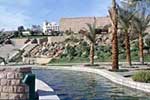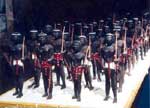|
The Nubia Museum
 The Nubia Museum harbors the history of the "Land of Gold" as
the word Nubia in the The Nubia Museum harbors the history of the "Land of Gold" as
the word Nubia in the
Hieroglyphic, language of ancient Egypt in which pictorial
symbols are used to represent
meaning and sounds, means the "Land of Gold"...Hence, this land,
over times, was abounding in monumental treasures.
The Nubia Museum, in Aswan, as a matter of fact, is deemed to be
one of the most
important Egyptian museums as it is the only unique open museum
of its kind and ranks tenth in the list of the museums
inaugurated in Egypt over the past three years. It is located in
Aswan on an area of 50,000 square meters, 7000 of which are
excluded to building, while the rest designed to be the yard of
the museum.
 Preparing this museum lasted for ten years, all dedicated for
hard work to come up with Preparing this museum lasted for ten years, all dedicated for
hard work to come up with
such lovely museum. Let alone, it stands as a wonderful model of
international cultural
cooperation representing in United Nations Educational,
Scientific, and Cultural Organization(UNESCO) which replied the
request of the Egyptian government to salvage the monumental
sites in Nubia, hence, the area between Aswan and the Sudan was
inundated by the Nile waters especially after completing the
Aswan Dam. On February 4th , 1986, the foundation stone of the
International Museum of Nubia was laid down.
The building has three floors for displaying and housing, in
addition to a library and
information center. The largest part of the museum is occupied
by the monumental pieces, reflecting phases of the development
of the Nubian culture and civilization.
 Three thousands pieces of antiquities , representing various
ages; Geological, Pharaonic, Roman, Coptic and Islamic, were
registered. Three thousands pieces of antiquities , representing various
ages; Geological, Pharaonic, Roman, Coptic and Islamic, were
registered.
It houses the statute of Ramsis II, which was laid at the very
forefront of the Museum,
statute of Amenras the spiritual wife of Amen, she is of Nubian
origin. It, also, has the head of the Shpatka, of the Nubian
origin, made of rosy granite, head of black granite of Tahraqa,
the Nubian King, whose reign during the 7th century BC was said
to be full of prosperity. There is a temple of his name with
gold-plated pillars.
 There are, also, four mummies for nobles, which were found in Kashmatkh town in Nubia. The museum, as well, houses several
models and styles of the Nubian heritage, the panorama of the
Nile, depicting live image of the River Nile streaming through
its banks. There is also a model for the Nubian-style house,
typically copied to mirror the nature of life in Nubia. All
pieces exhibited in the museum reflect the character of the
Nubia over history and display how it merged with the Islamic
civilization on one hand and the mother civilization of Egypt on
the other. There are, also, four mummies for nobles, which were found in Kashmatkh town in Nubia. The museum, as well, houses several
models and styles of the Nubian heritage, the panorama of the
Nile, depicting live image of the River Nile streaming through
its banks. There is also a model for the Nubian-style house,
typically copied to mirror the nature of life in Nubia. All
pieces exhibited in the museum reflect the character of the
Nubia over history and display how it merged with the Islamic
civilization on one hand and the mother civilization of Egypt on
the other.
So, the museum of Nubia plays vital role not only at the level
of promoting Nubia to the
entire world but also at the level of maintaining monuments and
supporting researchers,
interested in Nubia, from around the globe. |